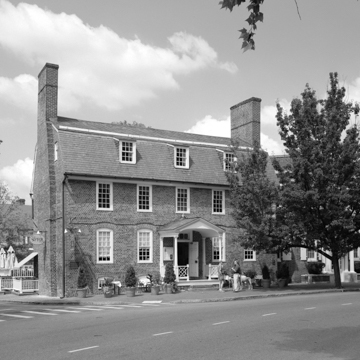Original owner William Reynolds operated a tavern named the Beaver and Lac’d Hat in this two-and-a-half-story gambrel-roofed structure. Characteristic colonial Annapolis features here include internal slab chimneys and an early use of all-header brick bond. The distinctive four-brick belt course enlivens the facade by following the segmental arches of the first-floor windows. In 1812 the building was converted into a banking hall and then bank officer’s residence for Farmers Bank of Maryland, the first bank in the nation to pay interest on deposits. Prominent bank officials lived in the structure until 1935. A proposal to demolish the vacant building and build a gas station mobilized prominent Annapolitans to save the former tavern. The Library Association of Annapolis occupied the property until 1974. After a restoration in the mid-1980s, Reynolds Tavern again houses a restaurant, bar, and overnight accommodations.
You are here
REYNOLDS TAVERN
If SAH Archipedia has been useful to you, please consider supporting it.
SAH Archipedia tells the story of the United States through its buildings, landscapes, and cities. This freely available resource empowers the public with authoritative knowledge that deepens their understanding and appreciation of the built environment. But the Society of Architectural Historians, which created SAH Archipedia with University of Virginia Press, needs your support to maintain the high-caliber research, writing, photography, cartography, editing, design, and programming that make SAH Archipedia a trusted online resource available to all who value the history of place, heritage tourism, and learning.









